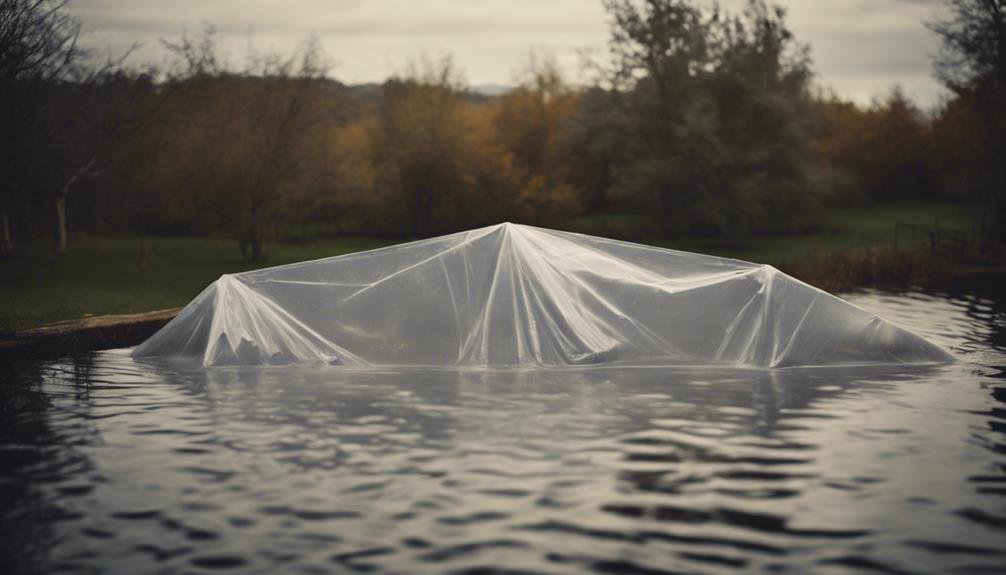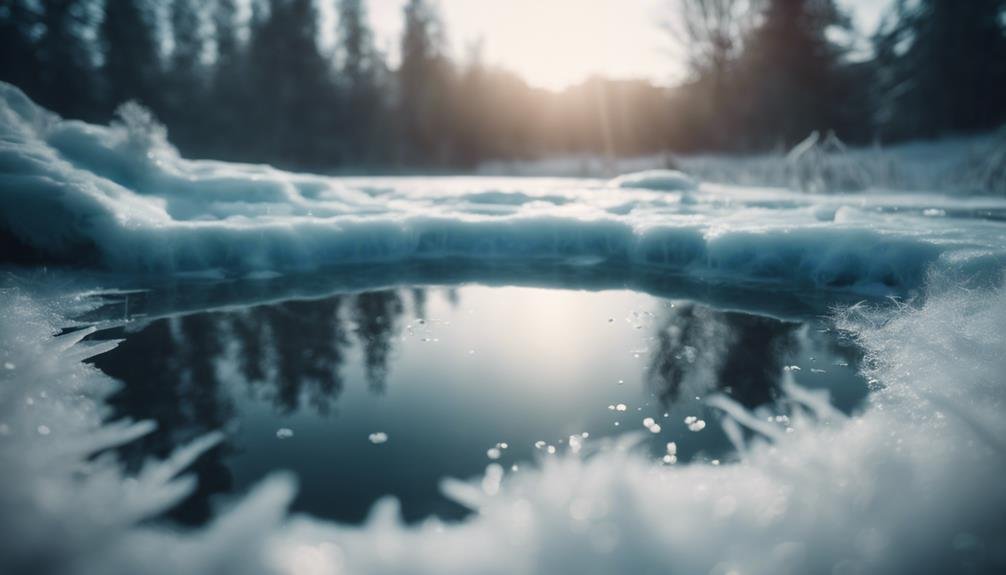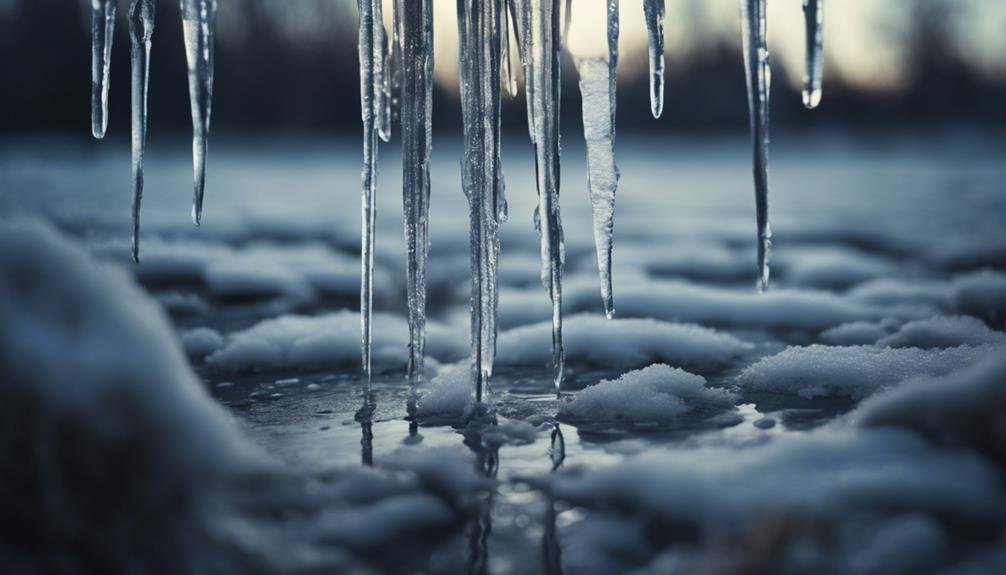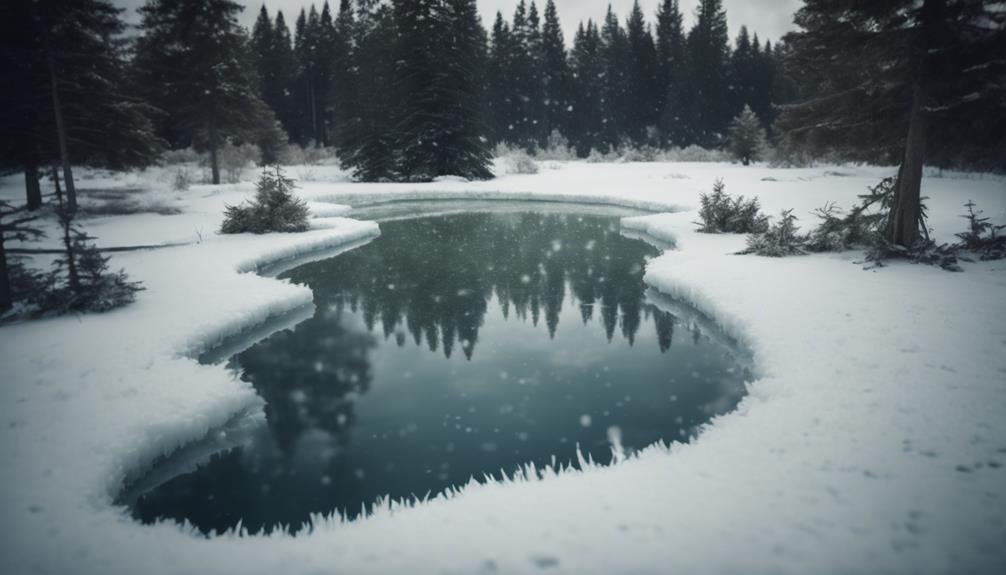There are several effective ways to keep pond water from freezing during winter. One method is to use floating de-icers or aeration systems that release heat or bubbles to prevent surface freezing.
Some of the links in this article may be affiliate links. If you make a purchase through these links, we may earn a small commission at no extra cost to you. Thank you.
Insulating covers can also help by trapping heat and creating an air pocket. Adding winter-hardy aquatic plants to the pond provides additional insulation. Pond heaters are another option to directly warm the water.
Maintaining water circulation throughout the winter can prevent ice formation and the buildup of harmful gases. Partially draining the pond can also help prevent complete freezing. Greenhouse enclosures made of transparent materials can provide insulation during the colder months.
Regular snow removal around the pond area can also help promote solar heating. By preparing your pond properly for winter, you can ensure a healthy environment for your aquatic life. It's important to explore these techniques further to understand the nuances and achieve the best results.
Floating De-Icers
To prevent pond water from freezing in winter, a practical solution is to utilize floating de-icers. These devices are specifically designed to maintain a section of the pond's surface free of ice, enabling vital gas exchange and ensuring that fish don't get trapped under a frozen layer.
Floating de-icers, powered by electricity, feature a heating element that warms the surrounding water, effectively melting any nearby ice formations. It's crucial to select a de-icer with the appropriate wattage that matches your pond's size to ensure efficient heating capabilities.
When setting up a floating de-icer, it should be placed near the center of the pond, away from edges and corners where ice tends to form first. Additionally, securing it with a cable or chain is essential to prevent drifting.
Since de-icers require a nearby power source, it's necessary to either use an extension cord or bury a waterproof cable underground to supply electricity.
Regular maintenance is key to keeping de-icers operational throughout the winter. Clearing any accumulated ice or debris from the unit's surface on a consistent basis maximizes heat transfer efficiency. With proper installation and care, floating de-icers can effectively maintain a section of your pond free from ice during the coldest months of the year.
Aeration Systems
Let's dive into aeration systems, crucial for preventing pond water from freezing in winter.
Diffused aeration systems release air bubbles from the pond's bottom, promoting water circulation and stopping ice from forming.
Another option is floating aerators, which sit on the water's surface, churning and aerating to disrupt ice formation.
Some de-icer units also function as aerators, providing both heat and aeration in one device. These systems are essential for maintaining a liquid environment in ponds during the colder months, ensuring the well-being of aquatic life.
By keeping the water oxygenated and in motion, aeration systems help prevent fish kills and maintain a healthy ecosystem.
It's important to choose the right aeration system based on the size and depth of your pond, as well as the specific needs of your aquatic environment.
Consider consulting with a professional to determine the best aeration solution for your pond.
Diffused Aeration Systems
Diffused aeration systems are essential for keeping pond water from freezing during winter by releasing bubbles that carry warmth from the bottom to the surface. These systems use an air compressor to pump air through diffuser membranes or discs placed near the pond's bottom. As the bubbles ascend, they create currents that circulate warmer water from the bottom, preventing the formation of a solid ice layer.
For optimal performance, it's recommended to install diffuser discs evenly across the pond's bottom. The number of discs needed depends on the pond's size and depth, typically requiring one disc for every 100-150 square feet of surface area. It's crucial to use an appropriately sized air pump and diffuser system to ensure efficiency and avoid energy wastage.
Although diffused aeration provides consistent de-icing and oxygenation benefits, it does require electricity to operate the air compressor, making it more costly than other de-icing methods like floating heaters or aerators. Proper sizing and regular maintenance are crucial for the system to function effectively and economically.
With a well-designed system, ponds can be kept liquid and healthy throughout the winter months.
Floating Aerator Types
When it comes to preventing freezing in ponds, floating aerators offer an alternative to diffused aeration systems. These surface-mounted devices, such as surface spray aerators and horizontal aerators, work by agitating the water to keep it from freezing solid.
Surface spray aerators operate by pumping water through a nozzle, creating a spray that disrupts the pond's surface before cascading back down. On the other hand, horizontal aerators float on the water, generating a horizontal flow that circulates the pond. Both types of floating aerators effectively promote water circulation, preventing ice buildup.
While surface spray aerators are more visible and produce some noise due to the spraying action, horizontal aerators operate more quietly. Combining these floating aerators with diffused aeration systems can maximize their effectiveness in preventing ice formation.
When choosing a floating aerator, factors such as pond size, depth, and local climate should be considered to ensure proper aeration and surface agitation throughout the winter months.
De-Icer Aeration Units
When it comes to keeping your pond from freezing in winter, de-icer aeration units are a great alternative to floating aerators. These units operate by releasing air bubbles into the water, creating a patch of open, unfrozen water at the surface. De-icers are particularly suitable for smaller ponds or areas near docks and shorelines due to their compact size and energy efficiency.
Typically, a de-icer consists of a weighted air diffuser linked to an electric or solar-powered air pump via tubing. The diffuser sits at the bottom of the pond, while the pump is placed on the shore. By pushing air through the diffuser, the pump produces a column of bubbles that transfers warmth from the deeper parts of the pond up to the surface, melting the ice cover.
Choosing the right size is crucial – we determine the de-icer's heating capacity based on factors like pond depth, the surface area needing ice melting, and the typical winter temperatures in your region. With a properly sized unit, you can preserve an area of open water to promote gas exchange and safeguard your fish from harm.
De-icers are simple to set up and require minimal upkeep, making them a convenient year-round aeration solution.
Insulating Covers

Insulating covers are essential for keeping pond water from freezing during harsh winter conditions. These covers are essentially floating blankets made from insulating materials like polystyrene or polyethylene foam. By floating on the water's surface, they create an air pocket that traps heat escaping from the pond, preventing it from dissipating and helping to maintain the water temperature above freezing.
One of the main advantages of insulating covers is their simplicity – they require minimal installation and just need to be placed on top of the pond. They also allow light to penetrate through, ensuring that underwater plants and fish receive the necessary light for survival. Moreover, insulating covers are a cost-effective solution compared to other methods like heaters or bubblers.
To ensure effectiveness, it's crucial to use covers specifically designed for ponds that can withstand outdoor conditions and remain buoyant. Checking the manufacturer's guidelines for proper sizing and installation is recommended to make sure the cover effectively prevents ice formation on your pond.
Plant Placement
When deciding where to place plants in your pond, it's crucial to include oxygenating pond plants as they release oxygen into the water, helping to prevent stagnation. These plants play a vital role in maintaining a healthy ecosystem in your pond.
Additionally, floating plants not only add beauty to your pond but also provide insulation by covering parts of the surface, helping to regulate water temperature.
It's also essential to choose hardy aquatic plants that can withstand cold temperatures and continue to provide oxygenation even during the winter months. Some excellent choices for winter-hardy pond plants include water lilies, hornwort, and anacharis. These plants won't only survive the colder months but also contribute to the overall health and balance of your pond ecosystem.
Oxygenating Pond Plants
Strategically placing oxygenating pond plants can help maintain oxygen levels during winter, preventing fish fatalities. It's best to group these plants near the pond's aerator or de-icer to make the most of the open water.
Plants like anacharis and cabomba, which grow underwater, are excellent choices as they release oxygen directly into the water through their leaves. Floating plants such as water lettuce and water hyacinth also play a crucial role by absorbing carbon dioxide and producing oxygen through photosynthesis at the water's surface.
To ensure optimal oxygen production, it's important to keep at least 60% of the pond's surface free from plant obstructions. This allows sunlight to penetrate and facilitates gas exchange with the air. Proper placement and density management of plants are key factors to consider.
Having too many plants can deplete oxygen levels as they decompose over winter. By strategically positioning robust oxygenating plants, you can create an oxygen reserve that benefits fish when oxygen levels decrease under ice cover.
Regular monitoring using a dissolved oxygen test kit will help you make any necessary adjustments for effective winter aeration.
Floating Plant Insulation
To shield ponds from freezing winter temperatures, strategic placement of floating plants is crucial. Covering 60-70% of the pond's surface with robust floaters like water hyacinths or water lettuce forms a protective layer, preserving liquid water beneath even when the surface freezes.
Begin by concentrating floating plants in the deepest parts of the pond to safeguard areas where aquatic life gathers during cold spells. Leave some open water near aerators or de-icers to ensure proper gas exchange.
As winter progresses, replenish the floating vegetation periodically, especially on warmer days when ice temporarily melts. The decaying plants sink, creating a natural compost layer at the bottom, offering additional insulation.
With adequate floating plant coverage, ponds can avoid freezing solid, enabling fish and plants to endure until the arrival of warmer spring temperatures. This thoughtful approach to insulation not only sustains pond life but also maintains a healthy ecosystem throughout the winter months.
Hardy Aquatic Plants
In addition to floating plants, it's essential to strategically place hardy aquatic plants around the pond's edge. These resilient plants can create a protective barrier that helps trap heat and prevents the water from freezing completely. Good options for this purpose include water lilies, cattails, and specific types of rushes or reeds that can thrive in freezing temperatures in your area.
Arranging these plants in dense clusters is key, as their foliage and stems provide insulation when packed closely together. This thick vegetation forms a protective layer over parts of the pond's surface, helping to maintain liquid areas.
Furthermore, the plants' root systems aid in generating heat through decomposition, adding to the effort of keeping sections of water from freezing.
During winter, as these plants naturally die back, their decaying matter creates a nutrient-rich environment under the ice. This environment supports beneficial bacteria and other microorganisms, which produce heat that can melt small areas of ice. This process allows gases to escape and oxygen to replenish near the plants, benefiting the pond ecosystem.
Pond Heaters

To keep your pond from freezing in winter, using pond heaters is essential. Submersible de-icers or floating heaters made for outdoor ponds are highly recommended. These heaters work by transferring heat into the water, preventing it from turning into ice.
When selecting a pond heater, make sure to choose one with the right wattage for your pond's size and depth. Consult the manufacturer's guidelines or a pond specialist for the best fit. Properly sized heaters will keep part of the surface ice-free while maintaining liquid water below, allowing for gas exchange and preventing toxin buildup.
Position the heater strategically for maximum efficiency, such as near the pond's edge or in a sheltered area to prevent heat loss.
Regular maintenance, like cleaning the heater's surfaces, is also important for optimal performance. By using a suitable pond heater, you can ensure your pond ecosystem stays healthy and active during the colder months.
Water Circulation
To keep your winter pond healthy, it's crucial to maintain water circulation and prevent stagnation. This can be achieved in various ways. One method is using a submersible pump to draw water from the bottom and release it at the surface, creating a continuous flow.
Another option is installing a small fountain or waterfall feature to aerate the water and prevent ice from forming. Additionally, placing a bubbler or aerator near the bottom can gently mix the water column by releasing air bubbles. In the deepest area, a small pool de-icer or stock tank heater can generate convection currents.
Water circulation is essential for distributing oxygen, preventing toxic gas buildup, controlling algae growth, and providing open water for fish and wildlife during the winter. By maintaining proper water movement, you can ensure good water quality and support aquatic life when the pond's ecosystem is most vulnerable.
Partial Draining

To prevent issues from freezing temperatures, consider partially draining the pond alongside maintaining water circulation. This method involves lowering the water level by a few feet to decrease the volume that could potentially freeze. By reducing the total water volume, the remaining water will be less likely to freeze solid due to milder temperature fluctuations.
To begin the partial draining process, locate the drain or overflow outlet and open the valve to allow some water to escape. It's crucial to monitor the water level closely and stop draining once you reach the desired level. Avoid draining too much water to prevent harm to any fish or plants residing in the pond.
Partial draining is often used in combination with strategies like water circulation and floating de-icers to protect the pond from freezing. This method minimizes the surface area exposed to freezing air while ensuring there's enough water for the pond inhabitants.
However, be cautious not to drain the pond excessively, as this could lead to complete freezing if the water level becomes too shallow.
Greenhouse Enclosures
One effective method to prevent pond water from freezing in winter is by building a greenhouse enclosure around the pond. This helps to trap heat and insulate the water, keeping it from freezing even in extremely cold temperatures.
Greenhouse enclosures work by creating a small climate that retains warmth from the sun during the day. The walls and roof of the enclosure can be constructed using transparent materials like plastic sheeting or polycarbonate panels.
It's important to ensure proper ventilation in the enclosure to allow air circulation and prevent excessive humidity buildup. Additionally, heating elements such as electric heaters or compost piles can be used to provide extra warmth if necessary.
Careful planning of the enclosure's size, materials, and ventilation system is crucial for its effectiveness. Proper insulation around the base and maintaining a clear covering will help maximize heat retention.
With the right setup, a greenhouse enclosure can be a great solution for keeping pond water unfrozen throughout the winter months.
Snow Removal

When it comes to preventing pond water from freezing, snow removal plays a crucial role alongside greenhouse enclosures. It's essential to regularly clear accumulated snow to allow sunlight to penetrate and warm the water beneath, thereby preventing the formation of a thick ice sheet. The method chosen for snow removal depends on the size and location of the pond.
Manual shoveling is a labor-intensive but cost-effective option suitable for small ponds. For medium-sized ponds, using a snow blower strikes a balance between effort and cost while being highly effective. Alternatively, heated cables or automated roof rakes are efficient solutions for larger water bodies, despite their higher initial cost.
By regularly clearing snow, sunlight can reach the pond and help maintain a suitable temperature for the aquatic ecosystem. This proactive approach not only prevents freezing but also promotes a healthy environment for fish and plants.
Choosing the right snow removal method based on the pond's size and characteristics is key to ensuring its well-being during the winter months.
Conclusion
We've seen how our neighbor's koi pond survived harsh winters with an aeration system and insulating cover. By following their example, we're sure our pond will stay liquid, protecting our aquatic plants and animals.
Taking these steps now will prevent costly damage later on, making it a smart investment in our pond's health and longevity.

